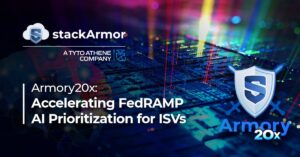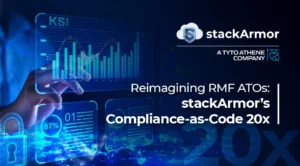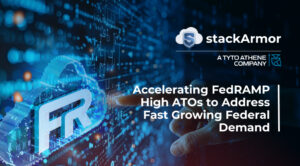According to research from Gartner, over 50 percent of cloud migrations exceed budget, do not meet migration timelines and/or result in unexpected disruption to business continuity. stackArmor is part of the GSA Cloud Adoption Center of Excellence (CoE) and has successfully supported the cloud adoption efforts at USDA, HUD, US Treasury and HHS/FDA amongst other Federal Agencies. A Center of Excellence (CoE) begins with a structured transformation plan with clearly established business goals and objectives. Organizations then must define their cloud solution architect based on the provided objectives to help realize the desired outcomes. The infographic below provides an overview of key building blocks that drive a well designed and proven Center of Excellence approach to cloud adoption and transformation.

stackArmor Cloud Adoption Center of Excellence (CoE) framework for driving enterprise digital transformation at scale
The stackArmor Cloud Adoption CoE framework been proven and refined based on large deployments and incorporates best practices both in the commercial and government sectors to help Agencies successfully implement cloud migration. The scope of the Cloud CoE needs to be tailored for every organization and presents a starting point in the cloud adoption journey.
Cloud Migration Planning
The creation of a well-defined cloud migration process helps speed up the ability to migrate from legacy data centers to a modern FedRAMP accredited commercial cloud service. The migration journey begins with a rapid system portfolio assessment using Gartner’s TIME model where systems are categorized into Tolerate, Invest, Modernize or Eliminate. The infographic below provides an overview of the migration process phases and activities to help drive cloud adoption at scale.

Figure: Cloud Migration Process flow with key decision points and analysis elements to execute a systematic cloud migration and modernization pathway
Application Portfolio Analysis
Cloud migration planning includes a series of structured activities to discover, profile and categorize applications. The analysis effort also maps and incorporates practices around application rationalization and categorization based on TBM (Technology Business Management) taxonomy. stackArmor’s Cloud team works with the agency stakeholders and program owners to collect information and assist with the segmentation of applications based on cost, time, and value to come up with recommendations for optimal migration paths.

Figure: Cloud Migration Pathways for selecting the optimal migration approach for specific applications based on the TIME analysis done as part of the Cloud Modernization Framework
The optimal cloud migration pathway is selected based on the cost, schedule and strategic value of the application or investment. Each of the cloud migration paths are explained in detail below.
Re-host – This is a “lift-and-shift” approach to rapidly migrating an application to a cloud service while minimizing changes required to execute such a migration. Optimizing the hosting environment to take advantage of commonly available constructs including but not limited to auto-scaling; deployment and operations automation; using PaaS or Cloud-native Managed Services are expected to accompany this migration pathway.
Re-platform – This migration approach is ideal for an application that has a specific cloud “incompatibility” that must be removed to perform a successful cloud migration. No functional changes are performed given that the objective is to execute and accomplish the fastest path to cloud migration by remediating the factor or factors that lead to incompatibility. The ability to take advantage of cloud services such as automation; elasticity and reduced need for management are expected to be used in this migration pathway.
Re-architect – This approach requires transforming the underlying application, data and systems components to use more efficient cloud-native services. The goal of this migration pathway is to deliver an advanced and modern architecture that takes advantage of the current state of the art patterns including microservices, serverless computing, AI and automation to deliver a high performance, secure and cost-efficient solution that meets customer performance requirements.




